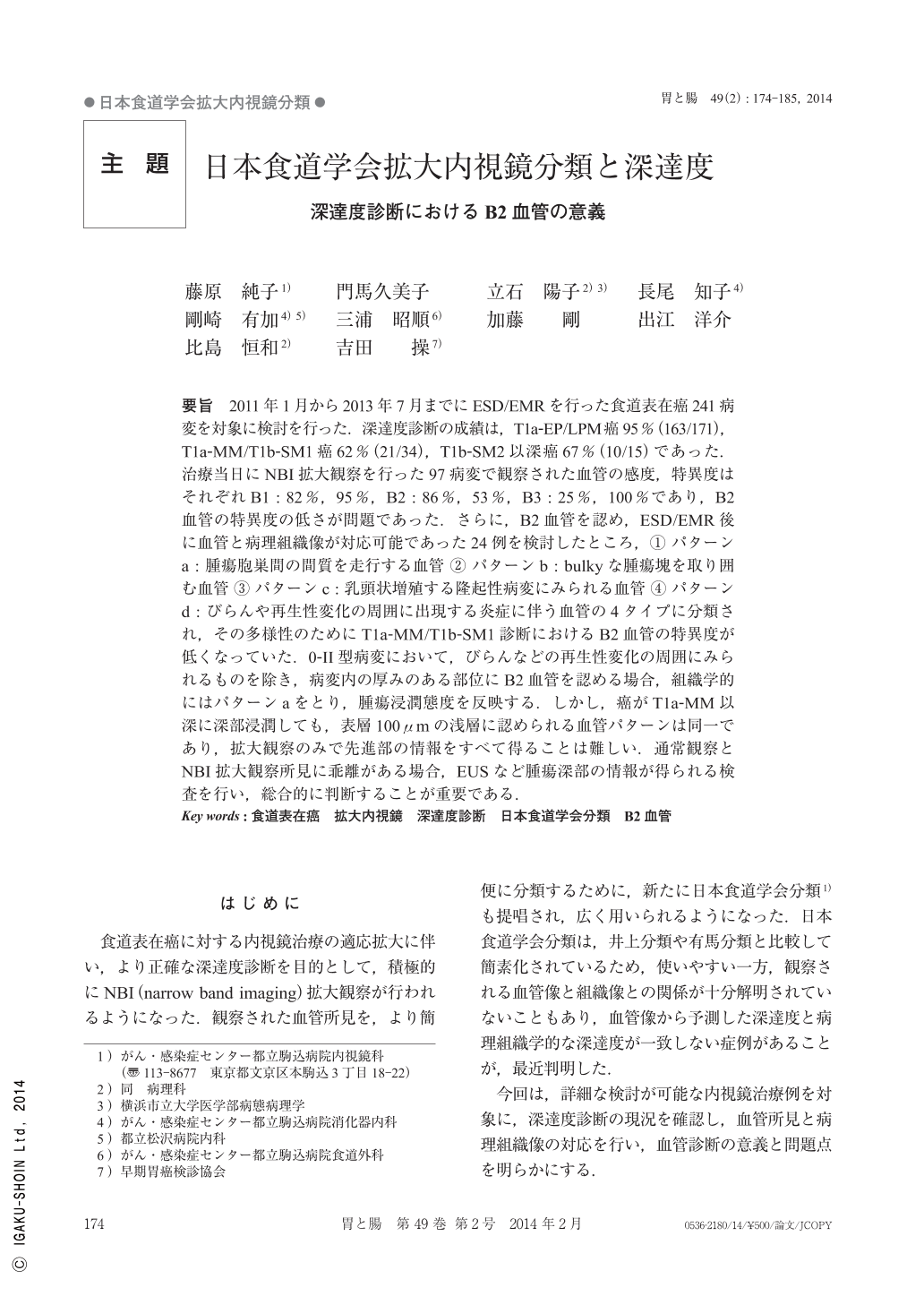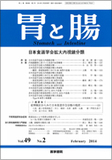Japanese
English
- 有料閲覧
- Abstract 文献概要
- 1ページ目 Look Inside
- 参考文献 Reference
- サイト内被引用 Cited by
要旨 2011年1月から2013年7月までにESD/EMRを行った食道表在癌241病変を対象に検討を行った.深達度診断の成績は,T1a-EP/LPM癌95%(163/171),T1a-MM/T1b-SM1癌62%(21/34),T1b-SM2以深癌67%(10/15)であった.治療当日にNBI拡大観察を行った97病変で観察された血管の感度,特異度はそれぞれB1:82%,95%,B2:86%,53%,B3:25%,100%であり,B2血管の特異度の低さが問題であった.さらに,B2血管を認め,ESD/EMR後に血管と病理組織像が対応可能であった24例を検討したところ,(1)パターンa:腫瘍胞巣間の間質を走行する血管(2)パターンb:bulkyな腫瘍塊を取り囲む血管(3)パターンc:乳頭状増殖する隆起性病変にみられる血管(4)パターンd:びらんや再生性変化の周囲に出現する炎症に伴う血管の4タイプに分類され,その多様性のためにT1a-MM/T1b-SM1診断におけるB2血管の特異度が低くなっていた.0-II型病変において,びらんなどの再生性変化の周囲にみられるものを除き,病変内の厚みのある部位にB2血管を認める場合,組織学的にはパターンaをとり,腫瘍浸潤態度を反映する.しかし,癌がT1a-MM以深に深部浸潤しても,表層100μmの浅層に認められる血管パターンは同一であり,拡大観察のみで先進部の情報をすべて得ることは難しい.通常観察とNBI拡大観察所見に乖離がある場合,EUSなど腫瘍深部の情報が得られる検査を行い,総合的に判断することが重要である.
In order to clarify the effectiveness of endoscopic observation of blood vessels using NBI(narrow band imaging)and magnifying endoscopy, 241 superficial esophageal cancer lesions were studied. All lesions were treated by ESD(endoscopic submucosal dissection)or EMR(endoscopic mucosal resection)from January 2011 to July 2013. The endoscopic classification of blood vessels(by the Japan Esophageal Society 2012)was employed. Accuracy of endoscopic estimation of invasion depth was attested by histological studies on resected specimens.
Invasion depth was correctly estimated in 95%(163/171)of T1a-EP/LPM cancer cases, 61.7%(21/34)in T1a-MM/T1b-SM1, and 66.6%(10/15)in T1b-SM2 or deeper. In cases with 97 cancer lesions endoscopic estimation of depth of invasion was carried out on the day of treatment. The sensitivity and specificity for depth of invasion were as follows : type B1 blood vessels ; 82%/95%, type B2 ; 86%/53%, and type B3 ; 25%/100%, respectively. Problem was the low specificity for B2 blood vessels. Histopathological images of B2 blood vessels were examined on 24 lesions. Histopathological images of B2 blood vessels could be classified into 4 types :(1)pattern a ; blood vessels that run across the interstitial tissue between the tumor nests,(2)pattern b ; blood vessels that surround the bulky tumor nodule,(3)pattern c ; blood vessels found in polypoid lesions with papillary growth, and(4)pattern d ; blood vessels with inflammation developing around ulceration and regenerative repair. This resulted in the low specificity for B2 blood vessels in the diagnosis of T1a-MM/T1b-SM1 cancers.
In type 0-IIc and 0-IIa lesions, type B2 blood vessels in the thickened part of the lesion strongly suggested cancer invasion of T1a-MM deep or T1b-SM1, excluding type B2 blood vessels in regenerative changes after ulceration. However, type B2 vessels may remain in the shallow layer 100μm from the surface of the mucosa while part of cancer infiltration reached T1a-MM or more, making it difficult to obtain correct estimation of invasion depth using magnifying endoscopy alone. When discrepancies in invasion depth are found between conventional and magnifying endoscopy, endoscopic ultrasound is recommended to obtain correct estimation of cancer invasion.

Copyright © 2014, Igaku-Shoin Ltd. All rights reserved.


